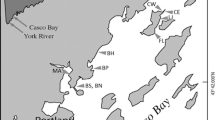Abstract
Macroinvertebrate density, biomass and drift were studied from moss-covered and moss-free channels in the South Fork Salmon River, Idaho. Insect densities were compared for 10 different substrate types and locations involving moss (Fontinalis neo-mexicana), sand, pebbles and cobbles. An ANOVA test demonstrated that insect densities varied significantly with substrate type (P < 0.05), and that total insect density in moss clumps differed significantly from densities in mineral substrates. Insect densities were 4–18 times greater in moss clumps than in mineral substrates under and adjacent to moss; sands under moss supported the lowest densities. During most tests, densities in pebble and cobble substrates adjacent to moss clumps were not significantly different from those found in similar substrates in the moss-free channel. The 20% moss-covered channel had 1.6 to 7.2 greater insect density and 1.4 to 6.1 greater biomass than did the moss-free channel for the tests conducted. Generally, midges (Chironomidae) made up over 50% of the insect community; annelids were the principal non-insect invertebrates.
In spite of greater insect density and biomass in a moss-covered than in the moss-free channel, we did not demonstrate universally increased drift of the immature stages from the moss-covered channel, at least during daylight hours. As a consequence, we infer that salmonid fishes, feeding primarily on drifting insects during the daytime, may not derive increased caloric benefit from moss habitats until the insects emerge as adults.
Similar content being viewed by others
References
Bjornn, T. C., M. A. Brusven, M. R. Molnau, T. H. Milligan, R. A. Klamt, E. Chacho & C. Schaye, 1977. Transport of granitic sediment in streams and its effect on insects and fish. Univ. of Idaho Forest, Wildlife and Range Exp. Sta. Bull. No. 17, 43 pp.
Brusven, M. A., 1970. Drift periodicity and upstream dispersion of stream insects. J. Ent. Soc. Brit. Columbia 67: 48–59.
Brusven, M. A. & K. V. Prather, 1974. Influence of stream sediments on distribution of macrobenthos. J. Ent. Soc. Brit. Columbia 71: 25–32.
Cummins, K. W., 1966. A review of stream ecology with special emphasis on organism-substrate relationships. Pymatuning Laboratory of Ecology, Special Publication 4: 2–51.
Edwards, R. W. & M. Brooker, 1984. In Whitton, B. A. (ed.), Ecology of European Rivers. Blackwell Scientific Publications, Oxford, London: 51–82.
Egglishaw, H. J., 1969. The distribution of benthic invertebrates on substrata in fast-flowing streams. J. Anim. Ecol. 38: 19–33.
Frost, W. E., 1942. River Liffey, Survey IV. The fauna of the submerged ‘mosses’ in an acid and an alkaline water. Proc. R. In Acad. 47B: 293–369.
Frost, W. & A. E. J. Went, 1940. River Liffey Survey III. The growth and food of young salmon. Proc. R. Ir. Acad. 46B: 53–80.
Glime, J. M. & R. M. Clemons, 1972. Species diversity of stream insects on Fontinalis spp. compared to diversity on artificial substrates. Ecology 53: 458–464.
Hynes, H. B. N., 1961. The invertebrate fauna of a Welsh mountain stream. Arch. Hydrobiol. 57: 344–388.
Hynes, H. B. N., 1970. The Ecology of Running Waters. University of Toronto Press. Toronto. 555 pp.
Lillehammer, A., 1966. Bottom fauna investigations in a Norwegian river: the influence of ecological factors. Nytt Magasin for Zoologi 13: 10–29.
Leudtke, R. L. & M. A. Brusven, 1976. Effects of sand sedimentation on colonization of stream insects. J. Fish. Res. Bd Can. 33: 1881–86.
Maurer, M. A. & M. A. Brusven, 1983. Insect abundance and colonization rate in Fontinalis neo-mexicana (Bryophyta) in an Idaho Batholith stream, USA. Hydrobiologia 98: 9–15.
Merritt, R. W. & K. W. Cummins, 1984. An Introduction to Aquatic Insects of North America. Kendall/Hunt Pub. Co., Dubuque, Iowa. 722 pp.
Minckley, W. L., 1963. The ecology of a spring stream: Doe Run, Meade County, Kentucky. Wildlife Monographs 11: 1–124.
Minshall, G. W., 1984. Aquatic insect-substratum relationships. In Resh, W. H. & D. M. Rosenberg (eds), The Ecology of Aquatic Insects. Praeger, New York, N.Y., 358–400.
Müller, K., 1954. Investigations on the organic drift in North Sweden streams. Report Drottingholm Inst. for Freshwater Res. 35: 133–48.
Percival, E. & H. Whitehead, 1929. A quantitative study of the fauna of some types of stream-bed. J. Ecol. 17: 282–314.
Rabe, F. W. & F. Gibson, 1984. The effects of macrophyte removal on the distribution of selected invertebrates in a littoral environment. J. Freshwat. Ecol. 2: 359–371.
Rooke, J. B., 1984. The invertebrate fauna of four macrophytes in a lotic system. Freshwat. Biol. 14: 507–513.
Walton, O. E., Jr., S. R. Reice & R. W. Andrews, 1977. The effects of density, sediment particle size and velocity on drift of Acroneuria abnormis (Plecoptera). Oikos 28: 291–98.
Waters, T. F., 1962. Diurnal periodicity in the drift of stream invertebrates. Ecology 43: 316–320.
Waters, T. F., 1972. The drift of stream insects. Ann. Rev. Ent. 17: 253–72.
Wiley, M. J. & S. L. Kohler, 1981. An assessment of biological interactions in an epilithic stream community using time-lapse cinematography. Hydrobiologia 78: 183–88.
Author information
Authors and Affiliations
Rights and permissions
About this article
Cite this article
Brusven, M.A., Meehan, W.R. & Biggam, R.C. The role of aquatic moss on community composition and drift of fish-food organisms. Hydrobiologia 196, 39–50 (1990). https://doi.org/10.1007/BF00008891
Received:
Revised:
Accepted:
Issue Date:
DOI: https://doi.org/10.1007/BF00008891




